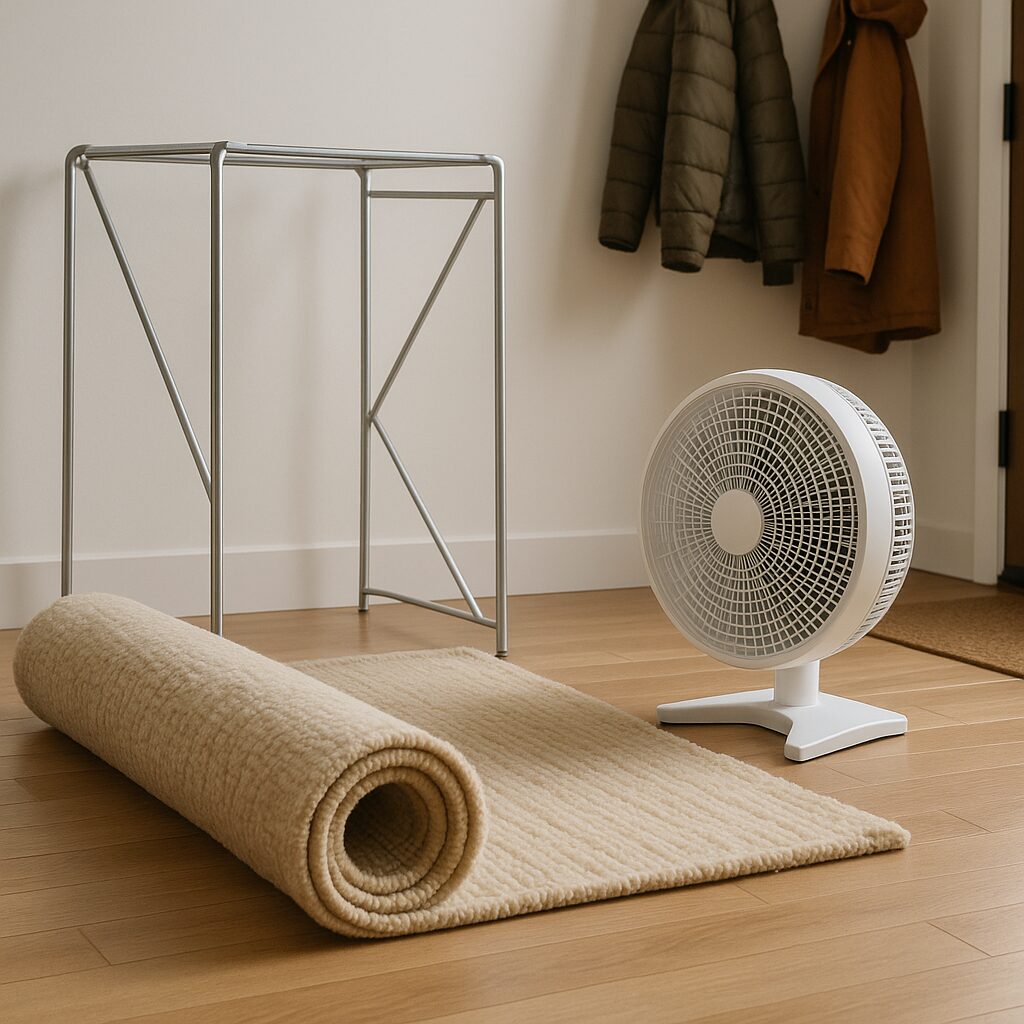Cold climates pose unique challenges for maintaining area rugs. Low temperatures, dry indoor air, and increased moisture from snow can result in:
- Fiber stiffness and cracking
- Slow drying, leading to mold or mildew
- Salt, mud, and moisture damage
- Fading in natural-dye rugs exposed to fluctuating humidity
If you live in a region with long, harsh winters, these factors can significantly shorten your area rugs lifespan unless you adapt your care routine accordingly.
How to Prepare Rugs for Winter
Pre-winter area rugs preparation is crucial. Think of it as setting up your rugs for hibernation, clean, protected, and ready to handle the season.
Key steps to prep your rug:
- Vacuum thoroughly: Remove deep-set dirt before it gets trapped by winter dampness.
- Deep clean: Consider a professional wash or a gentle DIY method to clear out allergens, oils, and dust.
- Apply fiber protectants: Use a cold-weather-safe rug protector to help repel spills, snow, and salt.
- Add insulated padding: This helps preserve warmth indoors and protects rug fibers from friction damage.
Area Rugs placed in high-traffic entryways are especially vulnerable. Layering them with washable mats or switching to synthetic blends during peak snow months can also be a smart seasonal swap.

Cleaning Rugs During the Winter
During winter, regular rug cleaning isn’t just about looks; it’s about preserving structure and health.
Can you clean rugs with snow?
Yes, but with caution. Traditional snow-cleaning works on dense, natural fiber rugs (like wool or Persian styles), but only when snow is dry and powdery.
How to clean with snow?
- Take the rug outside on a sunny, dry winter day.
- Lay it flat on clean snow, pile-side down.
- Beat gently with a broom to shake out dirt.
- Flip and repeat, then let it rest to absorb cold.
- Shake off the remaining snow and bring it inside to dry.
Important: Never use wet or melting snow. It introduces moisture and risks freeze-damage to the backing and fibers.
Low-moisture cleaning solutions are best for spot cleaning inside. Avoid overwetting; rugs take much longer to dry in the cold.
How to Dry Area Rugs in Cold Weather
Drying rugs in winter is tricky, especially without outdoor sun. Improper drying leads to:
- Mildew buildup
- Fiber rot
- Smells that linger even after cleaning
Tips for effective winter rug drying:
- Elevate rugs: Lay them flat on a drying rack or across furniture to allow air circulation underneath.
- Use indoor fans: Place fans nearby to speed up evaporation.
- Heaters help, but with caution: Don’t point heaters too close—use gentle warmth to avoid scorching the fibers.
- Avoid direct placement on radiators or vents.
Wool rugs especially need a slow and even drying process. Synthetic rugs dry faster but can retain odors if not fully aired out.
Regular Maintenance Through the Winter
Establish a winter rug care routine to prevent seasonal wear.
Weekly maintenance checklist:
- Vacuum once or twice a week (use a low-suction setting for delicate rugs)
- Inspect corners and edges for curling or moisture signs
- Blot spills immediately with microfiber towels
- Avoid walking on rugs with wet boots or socks
- Use rug-safe dehumidifiers in high-moisture zones
Tip: Rotate your rugs monthly to balance sun exposure and foot traffic.
If you have pets, place absorbent mats near doors. Snow, road salt, and mud on paws can degrade both rug color and texture.
Cold-Weather Maintenance by Rug Material
Not all rugs behave the same in cold conditions. Different fibers require different approaches:
| Rug Material | Cold Climate Behavior | Special Maintenance Tips |
|---|---|---|
| Wool | Absorbs moisture, insulates well | Air out regularly, avoid over-washing |
| Synthetic (e.g., nylon, polyester) | Resists cold, prone to static | Use anti-static spray, vacuum gently |
| Cotton | Dries slowly, traps moisture | Keep off damp floors, dry flat |
| Natural Fibers (jute, sisal) | Fragile in cold/damp | Avoid overwetting, dry clean only |
Wool remains the top choice for warmth, but it needs careful drying. Synthetics offer convenience but attract static electricity in dry winter air.
Storing Area Rugs During Winter
Some homeowners choose to store rugs in colder months, especially delicate or high-value ones.
When to store your rug:
- If it’s in a rarely used room that gets very cold
- If you’re replacing it with a winter-friendly rug
- If it’s vulnerable to moisture or heavy salt traffic
Storage best practices:
- Roll (never fold) rugs, pile side in
- Wrap in breathable fabric (like cotton or muslin)
- Elevate off the basement or concrete floors
- Use silica gel packs or cedar blocks to prevent moisture and pests
- Keep in a temperature-controlled space, not a freezing garage
Storing rugs properly also gives you the chance to refresh your winter interior. For example, Custom Cellular Shades in Manhattan offer both insulation and design upgrades, working perfectly with low-pile winter rugs in drafty apartments or houses.
Winter-Friendly Tools and Products
Using the right products makes all the difference in cold seasons.
Recommended tools:
- Low-suction vacuums with brush height adjustment
- Microfiber cloths for blotting
- Enzymatic cleaners that work in low temps
- Powder-based dry rug cleaners (for synthetic rugs)
- Room dehumidifiers and drying fans
Avoid steam cleaners in winter unless the space is well-heated and ventilated. Moisture left behind in cold rooms leads to slow drying and odor issues.
Eco-Friendly Rug Care Tips for Winter
Sustainability is still important—even in the cold.
- Use biodegradable cleaners that perform in cold temperatures
- Collect meltwater instead of using excess tap water
- Line dry rugs in sunny windows
- Refresh rugs with baking soda and essential oils as a dry-cleaning alternative
- Skip harsh chemical sprays that build residue
Reducing water usage helps prevent over-saturation and protects sensitive natural fiber rugs.
Should You Hire a Professional Rug Cleaner in Winter?
Sometimes, winter rug problems go beyond DIY.
Consider hiring a professional if:
- There’s a deep odor of mold you can’t remove
- You own expensive or antique rugs
- You don’t have a warm space to dry rugs safely
- Salt or rust stains have set in
Winter rug cleaning costs may be higher due to drying challenges, but reputable cleaners offer pickup/delivery and climate-controlled drying rooms.
When comparing providers, ask if they use cold-safe methods and how they handle indoor drying. Look for business with experience in winter-specific area rugs care.






